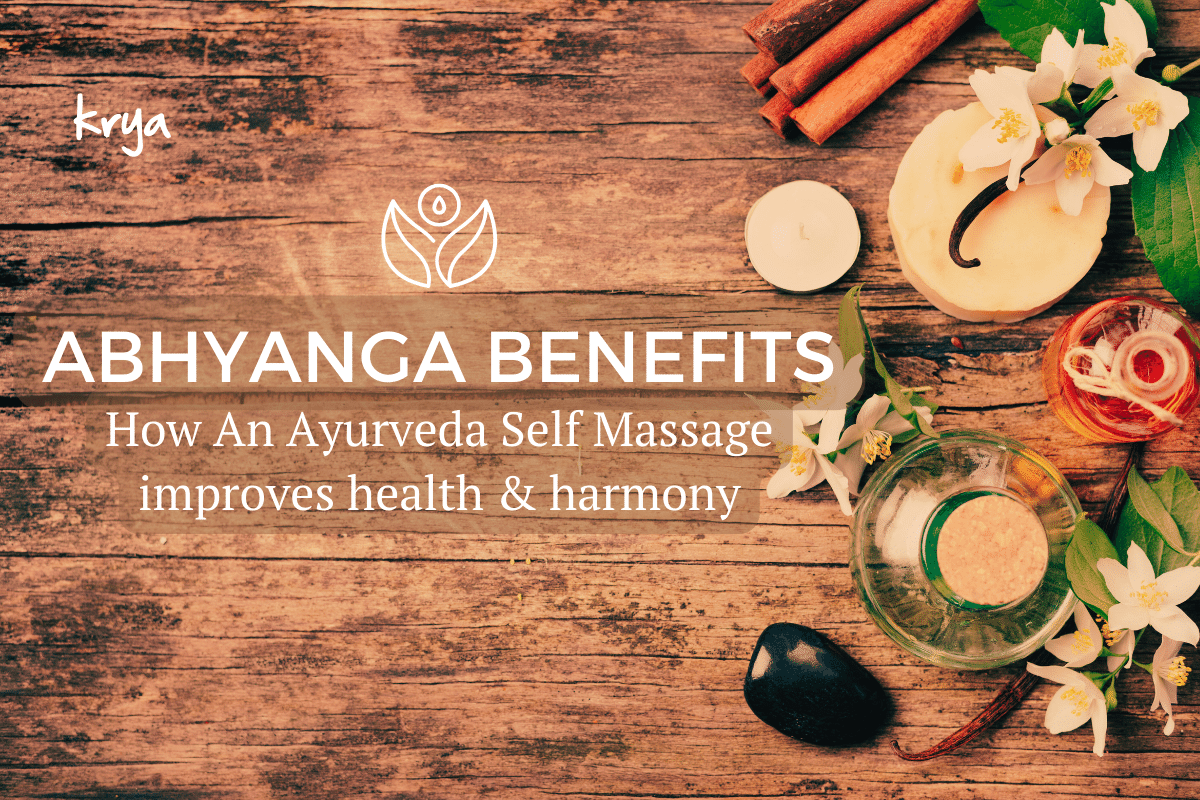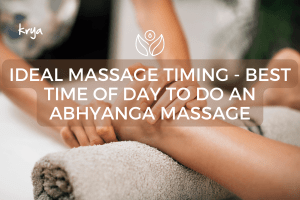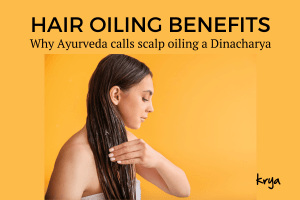This post was last updated on March 6, 2024 by Preethi Sukumaran
An Abhyanga is a key Dinacharya practice listed in the Ayurvedic texts. When done regularly, this simple-looking, yet highly powerful act of self-care, gives us both immediate and long-term health benefits. What are the benefits of a regular Abhyanga? What oil should you be using? How should you be preparing this oil? In this post, we will describe both abhyanga benefits and address other questions on Abyanga to get you started on this practice.
What is an Ayurvedic Abhyanga self-massage?
An Abhyanga is a part of every single Samhita and Ayurvedic text and is mentioned by every great Acharya from Acharya Charaka to Acharya Govind Dasji Bisagratna (of the Bhaisajya Ratnavalli) as an essential part of the Dinacharya (daily practices) for a healthy life. We have a detailed post on the history of Abhyanga and what the Brihat Trayee texts of Ayurveda have to say about this practice here.

The Dinacharya also describes practices like waking up at Brahma Muhurtha, quiet contemplation before dawn, Yoga, Pranayama and activities related to cleansing like the Gandusha and Snana.
An Abhyanga can be seen as a part exercise, part examination of the body, part toning of organ systems like the digestive system, maintenance of the musculo skeletal system, care of the skin and deep cleansing of the entre body. Most importantly, along with the above, the Abhyanga helps in balancing all 3 doshas of the individual, bringing the whole body back to a state of alertness, vitality and balance.
This definition of the Abhyanga from the Indian system of Ayurveda makes it very different from the western concept of a massage for relaxation, which is why at Krya, we insist on using the original Sanskrit term, ‘Abhyanga” and not the term massage to describe this Dinacharya.
Who can do / benefit from the Ayurvedic Abhyanga massage?
An Abhyanga can immensely benefit many age groups. Here are some examples :
- For the aged and infirm who cannot do strenuous exercise the abhyanga should be performed by a well-trained specialist . The muscles are worked out with the help of the correct Abhyanga oil, helping to slow down degeneration and decay. If a specialist is not available, a self-abhyanga can also be done. As old age is considered high in vata dosha a vata balancing , warming Abhyanga oil should be used.
- For the active sportsperson, the Abhyanga benefits include helping relax tense muscles, bring them back to a state of normalcy. It also prevents muscular tears due to stiffness and over use. As exercise excites vata dosha, a vata balancing abhyanga oil helps bring the body back to a state of balance. Performing abhyanga for active sportspeople or highly physically active people supports the repair and regeneration process. This reduces muscle injury and wear and tear of the bone & joint system.
- For the infant whose body is just developing, the practice of abhyanga helps support the body’s development. The benefits of massage include reaching the proper developmental milestones and better strength in bone and joint system. Here the Ayurvedic texts advise to use of nourishing, fatigue-reducing, and strengthening Abhyanga oil, specially formulated for a baby’s tender skin. There is a lot of importance in Ayurveda placed on daily baby massage. It is also suggested for the postpartum mother to support her recovery and strength.
- For the stressed working man or woman, the traditional Ayurvedic oil massage helps reduce excited vata and pitta dosha. One of the important abhyanga benefits is that it aids tranquillity and balance, pacifying the overwrought mind and body. So a vata and pitta calming, stress relieving and relaxing Abhyanga oil is suggested.
- For the post partum mother, the abhyanga specifically helps build the body’s immunity, and removes tiredness and exhaustion caused by childbirth and baby care. The overall effects of abhyanga are in rebuilding muscles and strength. Receiving abhyanga regularly from a professional or doing it by yourself helps strengthen the body, reduce exhaustion, and improve overall immunity.

Abhyanga massage benefits – how does the Abhyanga actually work?
Many of us live in cities. In Ashtanga Hridayam, a famous classical Ayurvedic text, Acharya Vagbhatta says that living in cities creates imbalance and lack of harmony within the body. This ends up vitiating Vata Dosha. When Vata dosha is excited and is at a high level, we develop high anxiety, inability to focus, poor immunity, and weakness in the bone and joint system.
Why does aggravated Vata dosha bring in these effects?
The Ayurvedic texts tell us that when Vata is in excess it contracts the minute channels (srotas) all over the body. This means that Rasa dhatu (lymph fluid) which is responsible for our strength and immunity has a narrower passage to flow through, which means that the body is depleted of its vital nutrients. When Rasa dhatu (lymph) is constrained, it in turn affects the free movement of rakta dhatu (blood).
When Rasa dhatu and rakta dhatu have a constrained flow in the body, we feel exhausted, fatigued, and mentally worn out. This can also make us feel easily overwrought, depressed and anxious in difficult situations.

When we feel this way, we may resort to external stimulants like energy drinks, tea, and coffee to help us keep going at work. Unfortunately, these substances can further aggravate and increase Vata dosha leading our body into a vicious cycle of imbalance.
This is why Ayurveda prescribes the use of an oil-based ayurvedic massage and eating a Vata-balanced diet in cases of vitiated Vata. Your Vaidya could sometimes additionally recommend vata-balancing medicines.
The external application of Ayurvedic herbal oil in the abhyanga works by trapping excess vayu (air) from the skin. As you massage the oil into the body, it helps trap vayu along with minute debris, dirt and dead cells through the skin surface. The trapped vata dosha is slowly released from the body and helps it leave the body through Sweda (sweat) generated after a vigorous abhyanga. As the action of the Abhyanga oil is warm, unctuous, and penetrating, it is the opposite of vata dosha which is cold, rough and light. The application of oil helps bring down the excess of vata dosha and restores the body back to a state of balance.
6 positive benefits of Abhyanga after 1 month of regular practice :
If you have been sincere about implementing small diet and lifestyle changes along with a once-a-week abhyanga, here are some changes you should see:
- As you practice abhyanga regularly, you should find it much easier to fall asleep. Insomnia or an inability to fall asleep easily is typically a symptom of vata aggravation. As your vata is brought back to a state of balance, you should be able to fall asleep much easier.
- One of the potential benefits of a regular abhyanga is better mental health. If you have been feeling maudlin, depressed, anxious and negative in general, you should be seeing a change in your disposition. Aggravated vata is considered to lead to mood swings and depression in the texts. When this is brought under control, you should see a change in your outlook on life.
- An important benefit of massage in Ayurveda is an improvement in digestion, appetite & easier bowel movements. Vata aggravation brings about inconsistency in digestive ability and appetite. Aggravated vata also dries up the entire gut area, leading to difficulty passing bowel movements or constipation. With vata under control you should be able to digest your food much better and should get hungry at roughly the same time and regularly every day. Bowel movements are also regular and easy.
- Research on abhyanga indicates that regular abhyanga improves energy & strength in the body. Vata dosha has its seat in the joints, lower back and all organs of movement including the neck and shoulders. When vata dosha is brought to a state of balance, you should experience vitality and new life in all these areas and should wake up feeling fresh and full of energy. Regular abhyanga can give a deep feeling of stability, groundedness and vitality in the body.
- Improvement in hair and skin texture – when vata goes out of control, the first 2 systems to feel its effects are your skin and hair. Your hair could become coarse, rough, brittle, have split ends and break easily when combed, when tugged or when wet. Your skin could also start looking rough, dull and can also start becoming much darker than usual. When your vata is under control, you should be able to observe lustre in your skin, an evening of skin tone and your hair should get much stronger. The elasticity of your hair should be slowly restored which means you should be able to comb / pull it without it snapping and breaking.
- Improvement in regularity & ease of menstrual cycles – An important benefit of the ayurvedic herbal massage is regularity in menstrual cycles and a reduction in pain. Menstrual cramping and PMS is associated with imbalanced vata and pitta dosha. This leads to mood swings, a feeling of being bloated, high cramping, and pain being associated with each monthly period. A regular abhyanga builds body strength and keeps vata and pitta in balance. This greatly eases and reduces period pain, cramping and PMS.

Why is sesame oil used in an Abhyanga oil? Will it suit everyone?
All Ayurvedic texts are unanimous in their opinion of Sesame oil. It is considered the best taila for pacifying vata aggravation. As vata aggravation is the most common cause of most diseases (50%), sesame oil is used as the base taila in almost all Ayurvedic medicated oil formulations for abhyanga , skin & hair. In fact when the texts do not specify the exact taila to be used and simply mention the word “taila” we take it to mean Sesame Taila as the word “Taila” is itself used interchangeably with sesame Oil.
We have mentioned that external application of taila requires a small amount of heat. This heat improves the penetrative ability of the taila and helps it enter the skin much faster. This heat also makes the action of the oil “sookshma” or minute and helps deliver the herbs to the body much faster.
This is why Sesame oil is preferred over oils like Eranda (Castor) even in applications for the hair. Despite the fact that castor oil is much more “cool” oil compared to Sesame which is required for hair and scalp applications, Castor is dense and not as Sookshma compared to sesame because of its cold nature. This means that castor does not work as fast as Sesame and is not as effective as sesame to deliver herbs to the body.

Depending on the formulations used, we can balance the nature of oils. However, it is important to note here that while Sesame is considered pitta in nature, it is not as pitta in nature like Mustard oil for example. So the Ayurvedic formulators were wise in recommending Sesame as the base oil of choice for tackling all Dosha based disorders.
Modern oils like Sunflower Oil and olive oil also come with a few drawbacks and are not as ideal as Sesame oil in the base of Abhyanga oil.
That said, abhyanga is a massage carefully designed in Ayurveda for dosha balance and harmony. This has to be done with a combination of oils + the correct herbs, processed in the oil in the correct way. Using plain vegetable oil, even sesame oil will not give us the results we are looking for in our Abhyanga practice.
Why we no longer recommend Abhyanga with plain Sesame oil
Your chosen Abhyanga oil must help your body, aid dosha balance, and restore health back to you.
Many people ask us if Sesame oil can give the same Abhyanga benefits we have spoken about above as an Ayurvedic Abhyanga oil. The short answer is no.
The rationale behind this is simple: all Tailas and Snehas are kapha promoting. By this, we mean that their consumption or application aids growth and strength if they are well absorbed by the body. However, this also means that if they are applied unprepared, you can quickly accumulate mucous in your body as kapha is also responsible for accumulating mucous in the body (along with accumulating strength).
There are therefore 2 issues with Abhyanga done with cold-pressed vegetable oils:
- They are not well absorbed by skin
- They can quickly accumulate mucous in the body leading to a depletion in energy and immunity
Oils like plain coconut oil, plain sesame oil, plain mustard oil, or plain olive oil should not be directly used for ayurvedic self-massage. Each oil comes with individual properties that may not be suitable to your constitution.

Secondly, the process of tila paka vidhi (ayurvedic oil manufacturing makes oil more subtle and easily absorbed by the skin.
Thirdly, this process and the herbs the oil is processed with, reduce their capacity to aggravate mucous in the body. Therefore we recommend choosing only a suitable Ayurvedic abhyanga oil for your massage therapy.
Do I need to heat Abhyanga oil for Self-massage
In Ayurveda, we do not reheat oil which has already gone through the Tila Paka process. However, warm oil does soothe vata and penetrates quickly. Hence, when you apply oil for abhyanga, apply the oil after warming the oil between your palms. If you live in a very cold climate, you can warm the oil in a water bath (and not on direct heat).
Can I use my Abhyanga oil for my hair too?
The short answer: No. As the head and body have different requirements.
Long answer:
The head carries the brain and the eyes, both of which are organs made up of fatty tissues. Kapha dosha is an important dosha here which has helped create the fatty tissues that make up both the eyes and the brain.
Heat melts kapha, so Ayurveda believes that it is important to maintain coolness in the brain, scalp, head and eyes for the organs to function well. The activity of these organs by themselves increases Pitta or heat in the body. As we see, process information, think and use our intellect we use up vital nutrients and generate heat in the body. So Ayurveda says we should constantly cool this area and apply tailas which soothe the brain and eyes, and allow them to relax and rest.
This is also the reason behind using only cool water to wash the eyes and lukewarm – body temperature water to wash the hair. Hot water should never be used above the neck area.
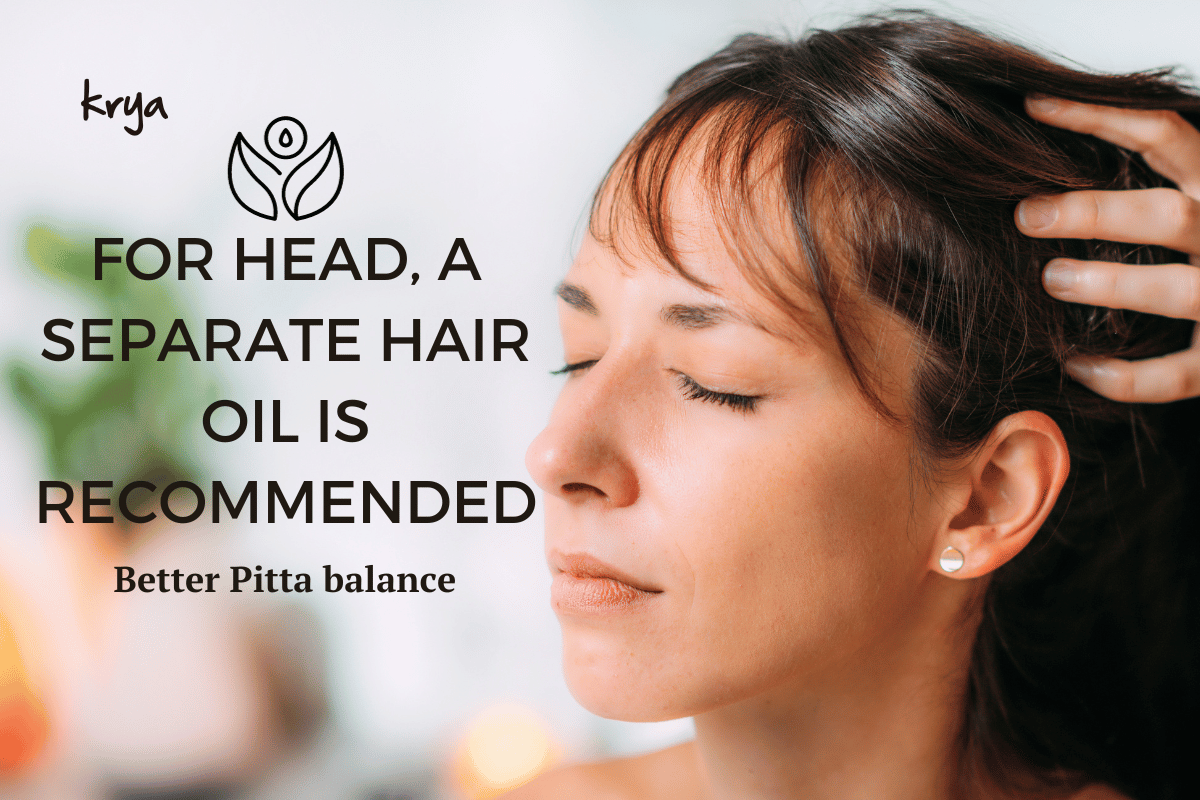
The taila designed for this area is therefore necessarily different. We use cooling, relaxing and soothing herbs like Bhringaraj, Brahmi, Nimba and Amla. All of these herbs balance pitta, help in the release of ushna (heat) from the scalp and cool and relax the brain and the eyes. In addition, as this area is high in kapha, we use sweet kapha promoting herbs that are useful in hair softness, and growth like Mulethi etc.
This is why Krya recommends a separate oil for the head and the body.
- If you apply your hair oil to your body, you could aggravate vata dosha further and could also upset Kapha dosha.
- If you apply your Abhyanga oil to your head, you could increase Pitta and heat in the body, which is the very thing we are trying to control in this area which is already very Pitta prone.
The application of oil into your scalp is also a dinacharya. Read about the benefts of Shiro abhyanga here and here .
Why you should apply Abhyanga oil on the soles of your feet: How is this beneficial?
Abhyanga oil application on the soles of yoru feet is called Pada Abhyanga. It is an excellent Dinacharya that nourishes the eyes, reduces fatigue and improves sleep quality. Do read our detailed post on pada abhyanga and its benefits here.
I dont have time for a full Abhyanga everyday. What can I do instead?
Why not try a mini Abhyanga? This is especially helpful for regulating and reducing menstrual cramps and is helpful if you are prone to spondylitis, and other bone and joint disorders. Read more about Mini abhyanga here.
What is abhyanga good for?
The benefits of Ayurvedic daily massage are many and accrue much more over the long term. In short , abhyanga acts as a re-set for the body, bringing all 3 doshas back to a state of harmony and balance. When done regularly, this gives you better strength, energy and immunity.
When should Abhyanga be done?
An Abhyanga should be done in the morning, as early as possible, on an empty stomach, and then followed with a Snana using warm water and the correct herbal ubtan. We have a detailed post on the correct Abhyanga massage timing here. Please refer to this for more details.

When should you not do abhyanga?
Abhyanga should not be done if you are unwell, have a fever, after a meal, after exposure to the hot sun, if you are feeling very tired, or during your periods.
How often should you do abhyanga?
Ayurveda suggests the application of oil into your body daily, before bath. This is why it is called a Dinacharya. However, many of us may not have the time for this. Therefore we recommend doing a full abhyanga atleast twice a week, a mini abhyanga 2- times a week and a pada abhyanga 4-5 times a week.
Who should not do abhyanga massage?
Patients, physically very ill, those who have any current bone and joint issue or fracture, and pregnant women should not do an abhyanga, unless okayed by their vaidya.
Should abhyanga be done everyday?
We have answered this above. If it can be done everyday, it would be excellent for health.
Can we do abhyanga after eating?
An abhyanga should only be done on an empty stomach. If done after eating, it could hamper digestion of the contents of the stomach and lead to Ama / toxin formation in the body.
Should abhyanga be done before or after shower?
An Abhyanga forms an integral part of the Ayurvedic Snana. If you live in a cold climate, the application of oil onto skin before bath reduces skin dryness and improves skin health. It brings down the drying effect of water and keeps skin in good health.
Therefore an abyanga should only done before a shower / bath.
What Abyanga oil should you use?
You could use an Abhyanga oil specifically recommended by your Vaidya. alternatively, here are some options from Krya:
- Krya Intense Abhyanga oil for Vata balance– suggested for those of lean – medium build, heavy exercisers, high stress and anxiety, insomnia
- To cleanse skin – Krya Intense Ubtan for Women OR
- Krya Intense Ubtan for Men

- Krya Classic Abhyanga oil for Pitta balance – suggested for those of medium – heay build, work long hours on screens, have eye fatigue and stress
- Cleanse with Krya Classic Ubtan for Women OR
- Krya Classic Ubtan for Men

- Krya Pushti – Ayurvedic Baby Massage oil – suggested for infants, toddlers and kids ; Also for lean built teens
- Cleanse with Krya Ubtan for Baby Girl OR
- Krya Ubtan for Baby Boy OR
- Krya Kids Ubtan for Girls OR
- Krya Kids Ubtan for Boys
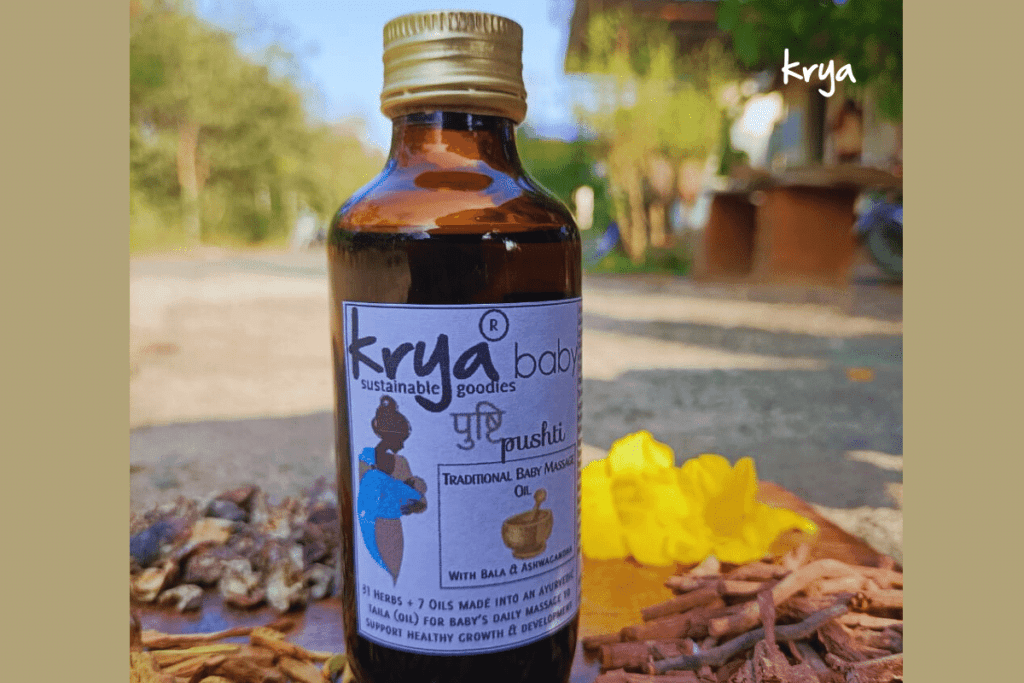
- For Post partum Moms – Combination of Krya Intense Abhyanga Oil + Krya Pushti Baby Massage oil – Combination suggested to nourish, improve strength and relieve fatigue
- Cleanse with Krya Intense Women’s Ubtan

